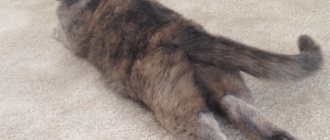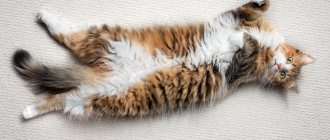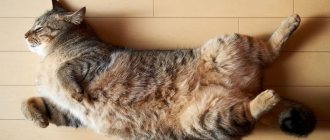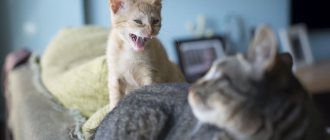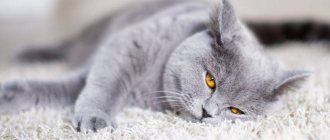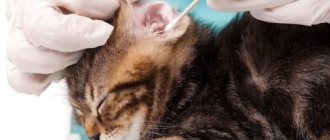Does the cat arch its back? Does she suddenly start running like crazy, as fast as she can, circling the room, jumping over couches or up and down the stairs, with her fur standing on end? It's very funny and interesting to watch, and at the same time scary, because she might bump into something and hurt herself. But she seems to be having a great time. Is it harmless fun or a cause for concern?
Most cats exhibit this behavior. Cat adventures, also known as periods of frantic random activity, are a normal and fun activity for them, although it can drive you crazy if they happen at 2 am.
When does this happen?
It comes out of nowhere. Sometimes the cat seems to “see” something invisible and starts running, or it may be in a playful mood, which may be aggravated by play. Cats also practice their stalking, hunting, and chasing behaviors, and this can cause them to arch their backs. There can be many reasons for this. After all, running is fun!
Kittens and young cats are more likely to fall into this state as they are full of energy and this can be a way of burning off excess energy. But sometimes even older cats can arch their back. Cats sleep most of the day when their owners are at work, so when they return home, the animals are awake and full of pent-up energy.
What is ataxia?
Without going into details, this is the name for a set of symptoms that imply problems with coordination of movements and body position in space. There are three types of this pathology:
- Cerebellar ataxia in cats is caused by damage to the cerebellum.
- Accordingly, vestibular occurs in cases where something is very wrong with the vestibular apparatus located in the inner ear.
- Sensitive . In some ways it is similar to the cerebellar, only in this case important nerve cords are damaged.
There are different causes of ataxia in cats. Most often, the development of the disease is due to:
- Poisoning with various poisons.
- Hereditary diseases accompanied by degenerative phenomena in the nervous tissue.
- Injuries that occur especially often in March, when loving cats fall from balconies.
- Lack of vitamin B1. This is generally typical for cats: many owners “pamper” them with fresh river fish, which contains the enzyme thiaminase. It destroys thiamine, that is, B1, resulting in ataxia. This is especially noticeable in kittens.
- If the cat is “hooked” on some plants. For example, a large dose of catnip can send a cat into “nirvana” for several minutes. At this time, the pet looks like an inveterate drunkard.
- Traumatic brain injury.
- Tumor.
- Infection. In particular, feline panleukopenia is very dangerous.
- Hydrocephalus or cerebral edema.
Should I worry?
Your cat may need more exercise. Set aside time every day to play with her and provide her with toys and puzzles filled with food. Change her toys to new ones periodically so that she doesn't get bored with them.
There are medical reasons why a cat may begin to exhibit this behavior. If an older or lazy cat suddenly becomes abnormally active and restless or behaves strangely, your veterinarian may want to check for any health problems such as feline hyperthyroidism (an overactive thyroid gland).
Older cats suffering from cognitive dysfunction syndrome or dementia may also begin to run around uncharacteristically. Cats that are experiencing physical changes, such as vision or hearing loss, may also begin to arch their back, and if this is a strange behavior for your pet, a visit to the vet is recommended.
Behavioral problems may be related to anxiety or stress, where the cat may become hypersensitive to stimuli in its environment and react by running uncharacteristically. Even flea or insect bites can cause her to arch her back to relieve irritation or severe itching, so check her coat for parasites.
If your cat shows any sudden changes in behavior, it is recommended that you take him to the vet to rule out any medical problems. If her behavior seems unpleasant and there is no medical explanation, seek help from a qualified cat behaviorist.
Behavior of domestic cats
The cat is a very intelligent and independent pet that was domesticated by humans many centuries ago. However, as in former times, representatives of the cat family value their freedom most of all. Having lived side by side with people for centuries, this intelligent pet has adapted to humans and learned to serve him faithfully.
Start understanding your cat perfectly
A domestic cat, through its behavior, lets its owners know what its desires are and its mood. If the cat owner knows the signals of the cat's language, then he will understand all the movements, facial expressions and sounds that his pet makes without words. It is difficult to find another pet that would have such a colossal arsenal of expressing its feelings and desires.
If a cat becomes scared, it bends its ears back and presses them to its head. At the same time, she crouches to the ground, sometimes completely clinging to it. And if she became very scared, then the pupils of her eyes become much wider, and the hair on the back of her neck stands on end. In some cases, the fur may rise up all over the body, which visually creates a larger volume of the cat's body. This is an evolutionary mechanism that has been developed over millions of years of existence of this species of animal, and its purpose is to intimidate the enemy with its large size.
The cat flattens its ears - you should be careful
If the cat sees that the threat was not fleeting, then it goes into the stage of active defense and tries to intimidate its enemy as much as possible. She extends her claws and begins to strike actively with her forelimbs in the air, demonstrating her aggressiveness and speed. At the same time, she begins to hiss loudly, but at the same time she is always ready to quickly leave the place of conflict.
Feeling fear, the cat rears up
One feature of the cat's behavioral traits should be noted: despite the fact that it considers its owner and other people living next to it to be its relatives, it at the same time realizes that it depends on people. She understands that by being close to a person, she thereby provides herself with additional protection, security and inviolability of the territory that she considers her own. Living next to human habitation, the cat will always be provided with food. This will relieve her of the need to hunt, which she would have to do in natural conditions to feed herself and her offspring. We can say that proximity to a person provides this animal with something like a cat’s pension, prolonging its life and providing additional security.
A cat is always aware of its dependence on a person
Freed from the need to worry about their food, cats give their affection to their owners, play with them and give them the maximum of their feline attention, which makes their owners so happy. At the same time, they jump into the arms of their owner, arch their backs, purr, rub against him lovingly, exposing their head and back for affection. There are many ways in a cat’s arsenal to show her attitude towards her owner, and if she is sick, she can trust him.
Cat owners have often noticed how happy their pet is when they step on the threshold of their home. The cat runs towards its owner, gently rubs against his legs and purrs loudly. However, many do not realize that this is not just an instinct, but a whole ritual that gives the cat no less pleasure than its owner.
If a cat is very excited or feels very threatened, confused or afraid, then it arches its back in an arc on which the fur stands on end.
However, such friendliness extends mainly to its owners. In relation to other cats, she is a great individualist and strives to communicate with them only during the mating season.
Cat shows claws in extreme cases
Just like other animals, a cat has its own territory in which it can feel proud and independent. Even cats that do not have their own home and owner do not wander anywhere, and those that live in natural conditions sometimes conquer a territory of up to one hundred hectares of field or forest. As for those cats that live in the city, they consider the garden or home of their owners to be their personal territory. At the same time, from time to time they carry out a kind of “revision” of this territory.
All animals that she considers strangers will definitely be expelled from this territory with all possible aggression on the part of the owner of the territory.
Knowing the psychology of a cat will make it easier for you to understand its behavior.
Considering this feature of cat psychology, the owner of the animal must ensure that the territory controlled by his cat is free from poisonous plants, broken glass, razors and other unsafe rubbish. It should be remembered that a cat that defended its territory was subjected to enormous stress, after which it can “move away” for a very long time. To make this process easier for her, the owner must take her in his arms, feed her something tasty, something that she especially loves, and then the cat will soon become playful again, as before, and give her owner many wonderful moments, purring at her. on his knees. Believe me, these minutes will remain in your memory for a long time!
If you find an error, please select a piece of text and press Ctrl+Enter.
Injuries or impairments
Photo: Hronika
It also happens that cats prefer not to put weight on their front paws solely because it is painful. Fractures, deformations, arthritis of the front legs, and other congenital and acquired anomalies - all this leads to the fact that the animal has to learn the least traumatic gait - on the hind legs. And in the case of traumatic amputation or congenital absence of limbs, in principle there is no alternative to such a gait.
We also think you might be interested to know why cats love to sleep on their owners. There are plenty of reasons for this too.
Preventing the appearance of mats in cats
It is easier to prevent tangles from appearing than to untangle and comb them out later. To do this, it is important to follow the following rules.
Health monitoring
It is recommended to regularly examine the cat at home, for example while brushing or playing, and to have a medical examination with a veterinarian 1–2 times a year. At the first signs of illness or the presence of alarming symptoms, the animal should be taken to the veterinarian as soon as possible.
Balanced diet
Proper nutrition, taking into account the daily need for nutrients, vitamins and minerals, taking, if necessary and only on the recommendation of a doctor, complex vitamin-mineral preparations, fatty acid complexes, and having clean water available at all times are some of the main conditions that have a beneficial effect on the beauty of the coat. pet.
Careful proper care
It includes combing and periodic washing using special shampoos selected taking into account the type of animal's coat, as well as additional cosmetics to facilitate combing. In addition, it is important to prevent the air in the room where the pet lives from drying out.
For daily combing of fluffy cats, you will need combs with sparse, non-sharp teeth and special brushes. It is better to carry out the procedure in several stages so as not to cause fatigue and irritation to the animal. When combing, special attention is paid to the armpits, belly, tail, and areas behind the ears. It is necessary to accustom a cat to such manipulations from an early age. In addition, daily brushing helps not only maintain the aesthetic appearance of the coat, but also strengthens the emotional connection between the owner and the cat, allowing you to show your pet your love and care.
How does a cat's tail work?
A cat's tail is an extension of its spine, or rather its spine. Based on an anatomy textbook, a cat's tail is usually divided into three parts: the base, the stem and the tip. The tail consists of 19–28 vertebrae. All vertebrae are oval in shape, connected by cartilage tissue and wrapped in muscles. The vertebrae have openings through which the spinal canal passes.
The tip of the tail consists of 5–7 vertebrae. The last vertebra may be undeveloped or pointed. The intervertebral cartilages are thickened, which gives the tail its characteristic flexibility. In each cavity between the vertebrae there are branches of nerve endings. You don't need to be a doctor or veterinarian to understand that a cat's tail is very sensitive .
The purpose of a cat's tail is not obvious. With the help of its tail, the cat balances and maintains balance. When running at high speed, a cat turns into turns using its tail to shift its center of gravity. However, the obvious purpose of the tail comes down to communicative functions . Simply put, a cat shows its intentions and emotions by adopting a certain posture.
Symptoms and diagnosis
In general, the symptoms of ataxia in cats are simple. The pet looks like a drunkard, he shakes, the cat cannot walk normally, in severe cases he falls on his side with a roar, just trying to sit down. A constant tilt of the head to one side, as well as erratic circular eye movements, are very typical. Other symptoms may vary depending on the underlying cause of the ataxia. For example, a cat “under mint” can walk with a wobbling gait with its head held high; from time to time, it shakes it and generously splashes saliva around. It looks terrible, but goes away quickly.
Your veterinarian will perform a complete physical examination of your cat. The information provided by the cat's owner is important. It is advisable to remember the following:
- Did the animal have access to household chemicals, poisons, or was deratization (rodent extermination) carried out in your home or area?
- Is there any information in your pet’s pedigree about any pathologies that the cat’s parents suffered from?
- Did the cat fall from the balcony, did it get hit by a bicycle, etc.
Inspection of the territory
Photo: Lockerdome
When a cat can climb something high, he does it. When he can’t, in order to be aware of what’s happening around him, he has to stand on his hind legs. This somehow increases the field of view, especially if there is thick and tall grass around. The Joinfo.com team and journalist Artem Kostin remind us that many animals do this in the wild, for example meerkats.
